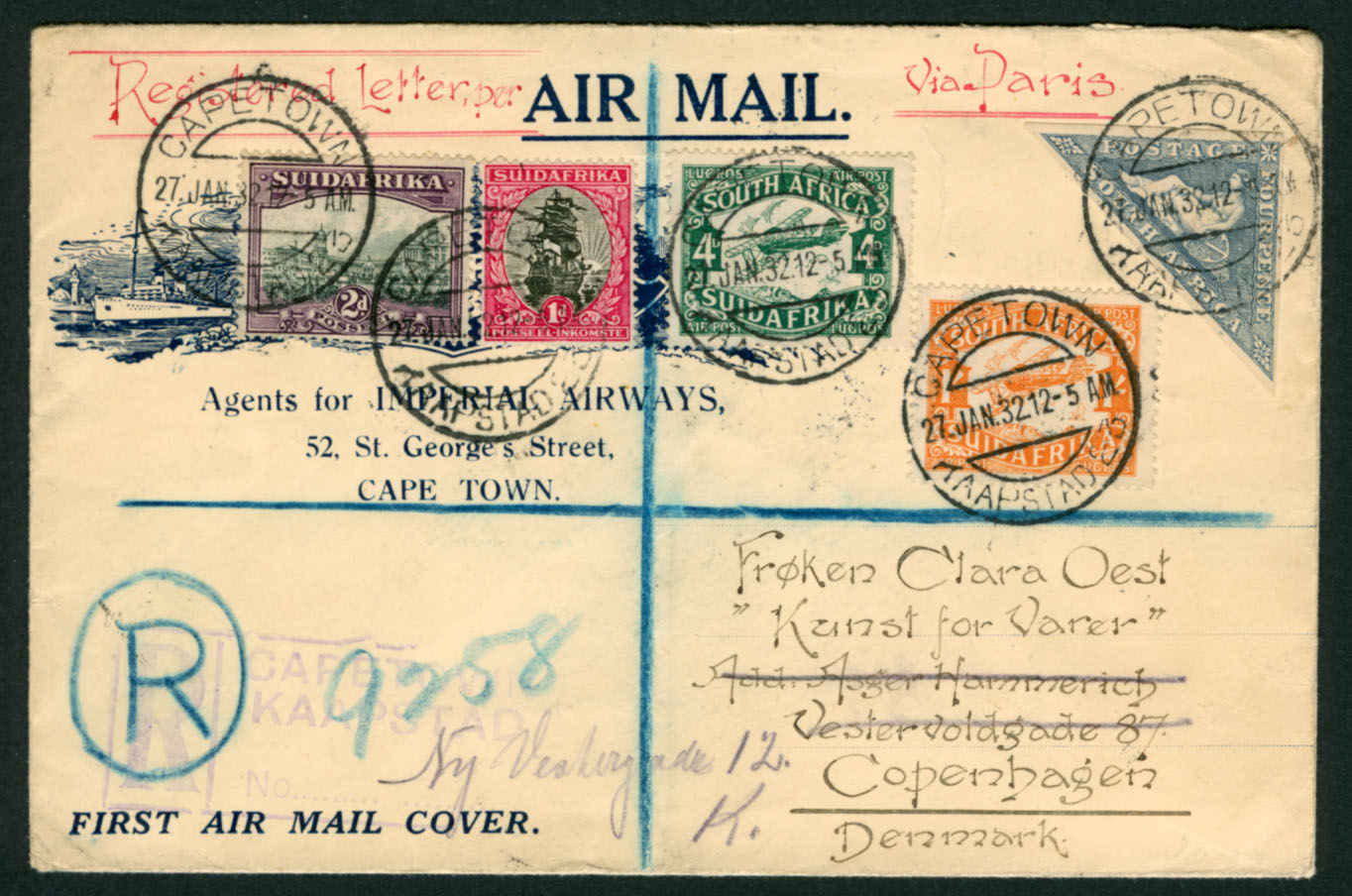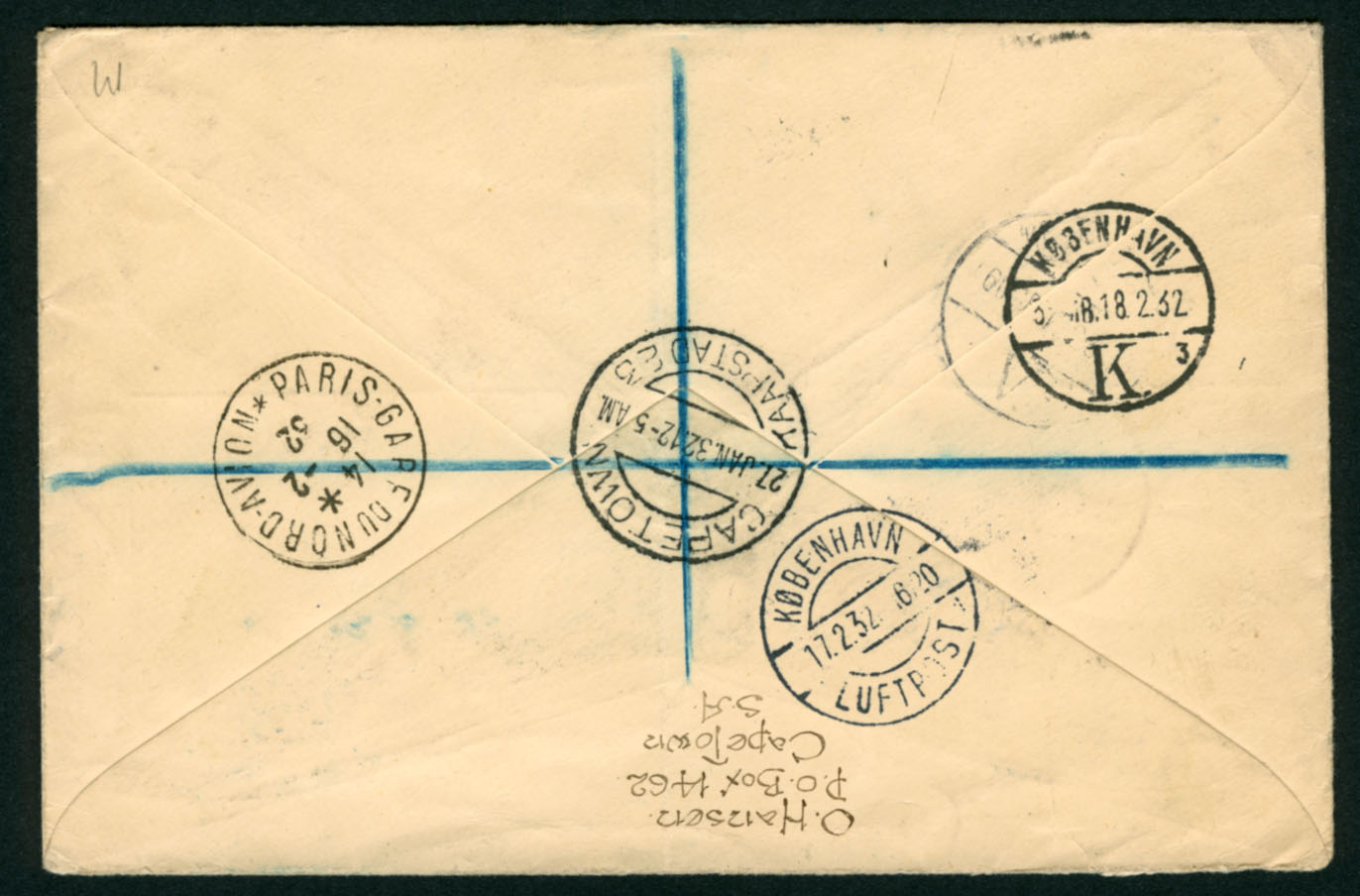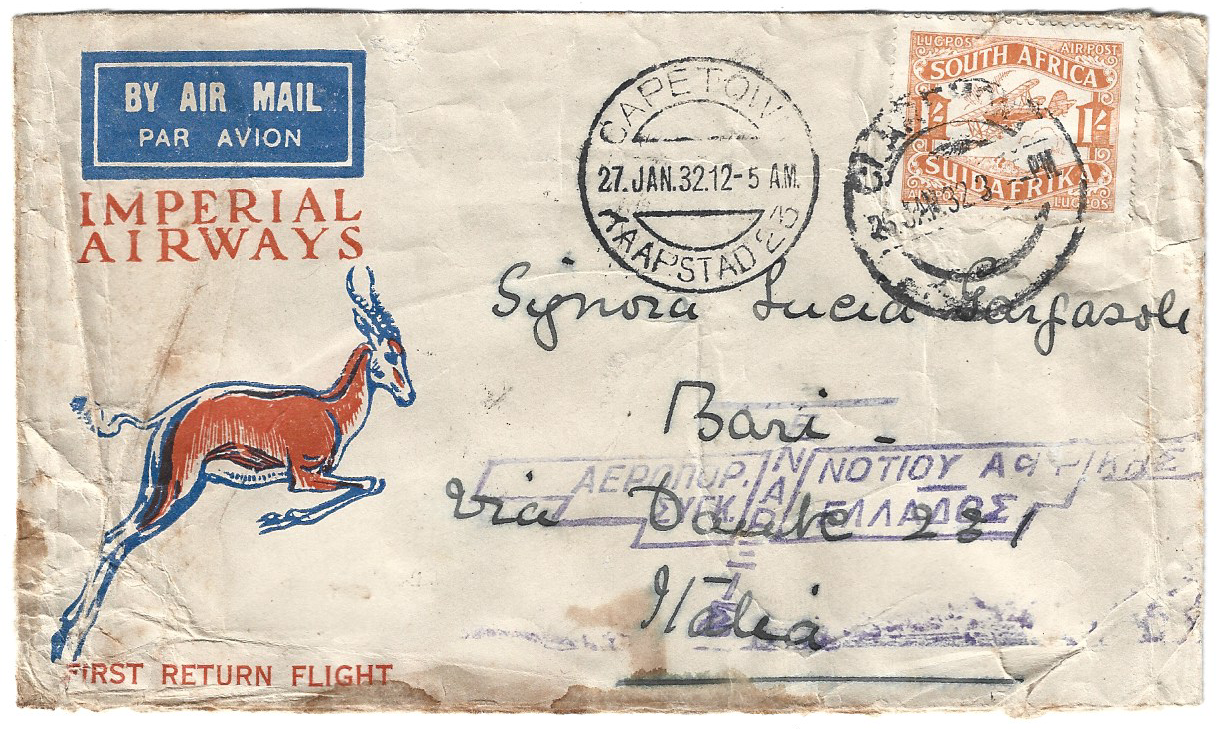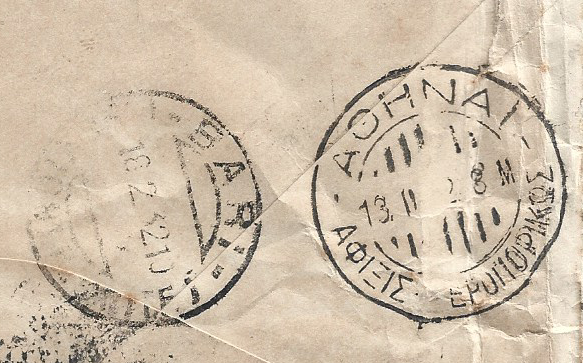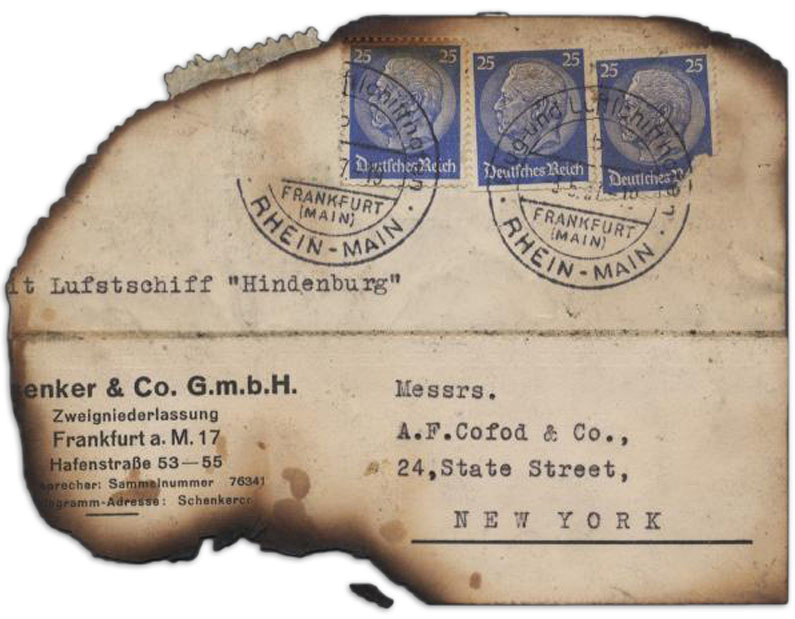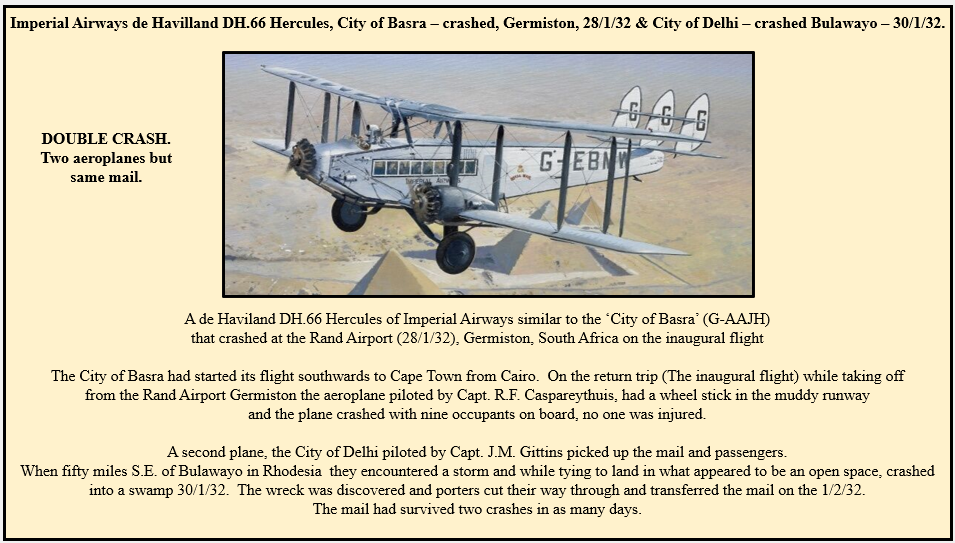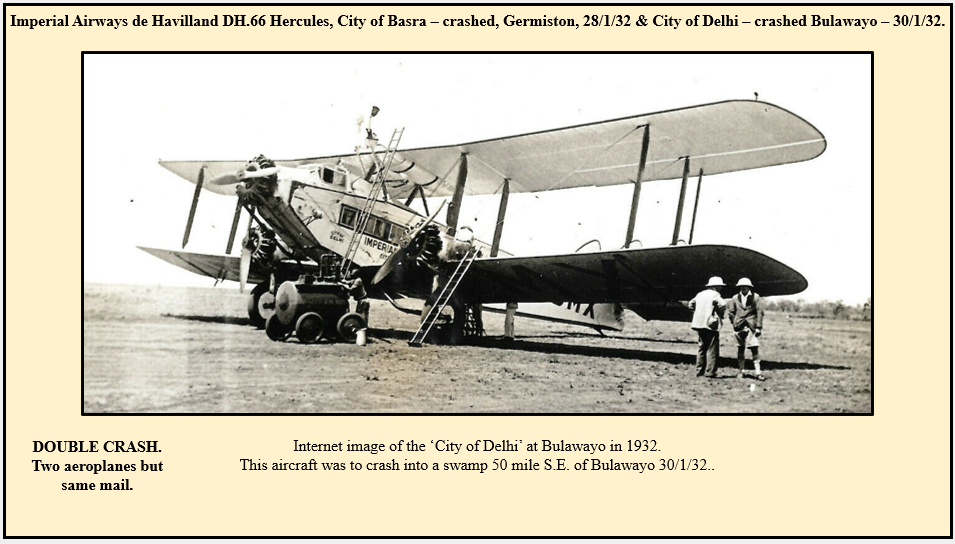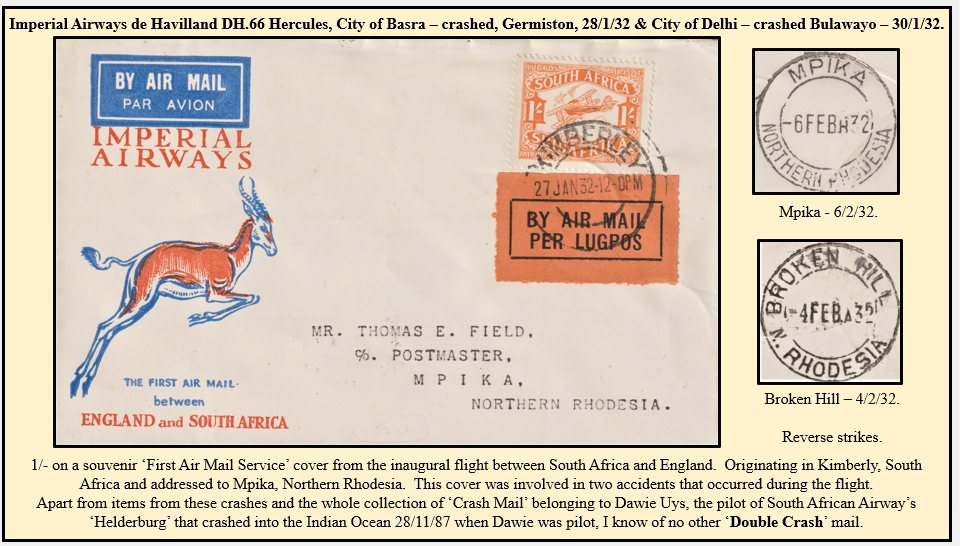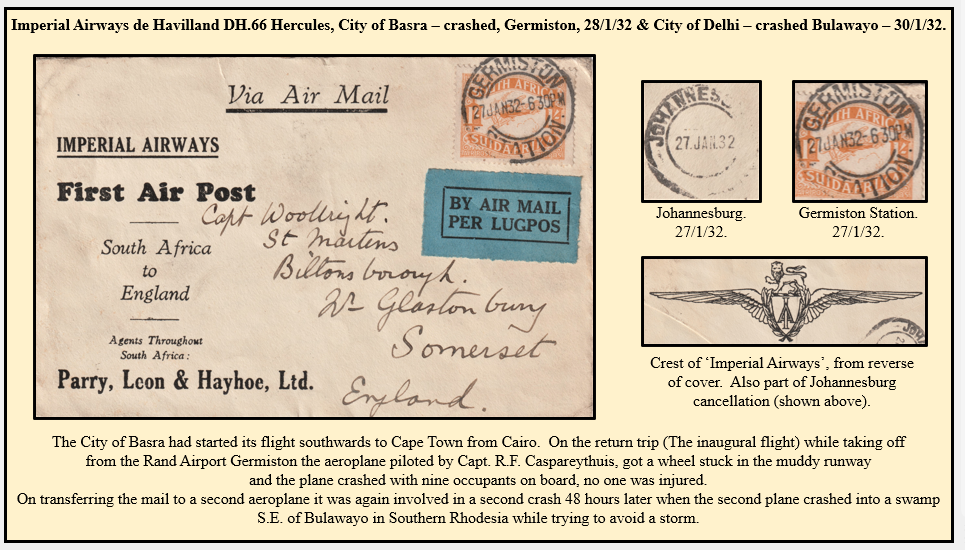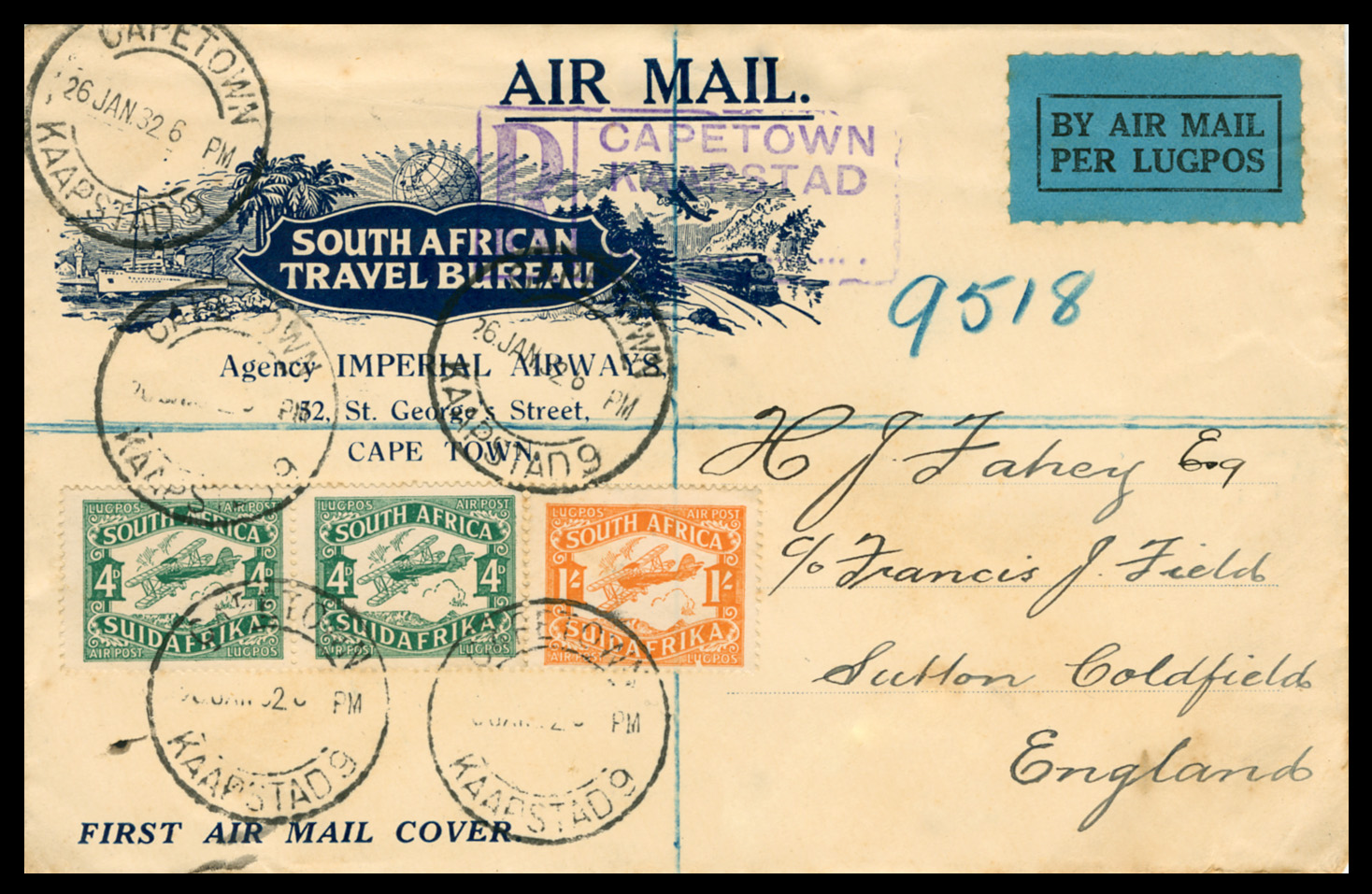Airmail First Flight Covers
Quote from Steve on May 25, 2021, 10:47 amCan anyone help me with the cover below, please. It claims to be a first flight cover but I am not so sure. This is not my field of expertise at all. Any help you can offer will be greatly appreciated.
The cover is from the South African Travel Bureau (hidden by stamps), an Imperial Airways agent in Cape Town. The cover is commercial postal stationery pre-printed 'AIR MAIL' and 'FIRST AIR MAIL COVER'.
It is a Registered Letter rubricated 'Registered Letter per (pre-printed 'AIRMAIL') .... Via Paris' at the top.
It is addressed to Copenhagen, Denmark. The front cover's stamps have been cancelled CAPE TOWN KAAPSTAD ' 27 JAN 32'.
The reverse shows the route taken:
CAPE TOWN KAAPSTAD ' 27 JAN 32'.
PARIS GARE DU NORD AVION '16 2 32'
KOBENHAVEN LUFTPOST '17 2 32'
KOBENHAVEN K '18 2 32'The 20 days taken from Cape Town to Paris seems long for Airmail, even in 1932. It is approximately the time taken by a sailing ship. It appears to have flown from Paris to Copenhagen but how did it get to Paris if it went by sailing ship?
Can anyone help me with the cover below, please. It claims to be a first flight cover but I am not so sure. This is not my field of expertise at all. Any help you can offer will be greatly appreciated.
The cover is from the South African Travel Bureau (hidden by stamps), an Imperial Airways agent in Cape Town. The cover is commercial postal stationery pre-printed 'AIR MAIL' and 'FIRST AIR MAIL COVER'.
It is a Registered Letter rubricated 'Registered Letter per (pre-printed 'AIRMAIL') .... Via Paris' at the top.
It is addressed to Copenhagen, Denmark. The front cover's stamps have been cancelled CAPE TOWN KAAPSTAD ' 27 JAN 32'.
The reverse shows the route taken:
CAPE TOWN KAAPSTAD ' 27 JAN 32'.
PARIS GARE DU NORD AVION '16 2 32'
KOBENHAVEN LUFTPOST '17 2 32'
KOBENHAVEN K '18 2 32'
The 20 days taken from Cape Town to Paris seems long for Airmail, even in 1932. It is approximately the time taken by a sailing ship. It appears to have flown from Paris to Copenhagen but how did it get to Paris if it went by sailing ship?
Uploaded files:Quote from Andrew Massyn on October 26, 2022, 6:10 pmHi Steve
I am a bit of a novice but was researching this recently.
On 09 December 1931 Imperial Airways extended its Africa Route to Cape Town for the carriage of Christmas Mail, and the mail only route was opened on 20 January 1932. On 27 April 1932 passengers were permitted for the first time. .The aircraft used on this route were the Hanley Page HP 42 Biplanes or De Havaland DH66 biplanes. (Sources Differ). As far as I can determine the route was London, Cairo, Khartoum, Juba, Nairobi, Mbeya, Salisbury, Johannesburg and Cape Town (or Backwards :). However, The route also stopped at Athens, from where the mail was then rerouted to another airline.
Presumably there was a similar re routing via Paris.
See here: https://www.thisdayinaviation.com/20-january-1932/#:~:text=The%20flights%20would%20leave%20Croydon,passenger%20service%20was%20soon%20added.
and here: https://en.wikipedia.org/wiki/Imperial_Airways
Hi Steve
I am a bit of a novice but was researching this recently.
On 09 December 1931 Imperial Airways extended its Africa Route to Cape Town for the carriage of Christmas Mail, and the mail only route was opened on 20 January 1932. On 27 April 1932 passengers were permitted for the first time. .The aircraft used on this route were the Hanley Page HP 42 Biplanes or De Havaland DH66 biplanes. (Sources Differ). As far as I can determine the route was London, Cairo, Khartoum, Juba, Nairobi, Mbeya, Salisbury, Johannesburg and Cape Town (or Backwards :). However, The route also stopped at Athens, from where the mail was then rerouted to another airline.
Presumably there was a similar re routing via Paris.
Quote from Steve on October 27, 2022, 2:15 pmThanks for the advice and the links, Andrew.
The problem for me with this cover is that it is travelling from Cape Town to Copenhagen via Paris on the route Imperial Airways used from Cape Town to Johannesburg, Salisbury, Mbeya, Nairobi, Juba, Khartoum, Cairo and London.
As your advice shows, on 28 February 1931 Imperial Airways started a weekly service began between London and Mwanza on Lake Victoria in what was then Tanganyika (Tanzania today) as part of the proposed route to Cape Town. Almost a year later on 9 December 1931 the Imperial Airways' service for Central Africa was extended experimentally to Cape Town for the carriage of Christmas mail. The aircraft used on the last sector of this route was DH66 G-AARY 'City of Karachi' which arrived in Cape Town on 21 December 1931. How long was it in Cape Town for? Presumably it left shortly after arriving ie. before 20 January 1932.
On 20 January 1932 a mail-only route to London to Cape Town was opened. On 20 January Imperial Airways’ Handley Page HP.42, G-AAXF, named Helena, departed Croydon Aerodrome, South London, England, on the first leg of the airline’s new intercontinental mail service to the Union of South Africa. The flights were scheduled to leave Croydon at 12:30 p.m. every Wednesday and arrive in Cape Town on Friday, ten days later. The route was London, Cairo, Khartoum, Juba, Nairobi, Mbeya, Salisbury, Johannesburg and Cape Town. The first flights only carried mail. A scheduled passenger service was soon added. On 27 April this London to Cape Town route was opened to passengers at a cost of £130. The flight was scheduled to take 10 days.
Presumably this was a weekly service in both directions. If it was a weekly service it possibly explains how the cover left Cape Town on 27 January, a week after the opening of the service in London.
As Paris was not on the Cape Town to London route, this mail either went to London - there is no London receiving nor transit datestamp so I assume it never arrived there - or it was re-routed to Paris somewhere else, possibly in Cairo. If this was the case you would expect to see an Egyption receiving and or departure datestamp but there are none! Wherever this cover was re-routed to Paris there are no postmarks to prove the route this cover took to arrive in Copenhagen on '17 2 32'?
I will take this cover to the SACS meeting in Meriden on 5th November and show it to an expert. Watch this space!
Thanks for the advice and the links, Andrew.
The problem for me with this cover is that it is travelling from Cape Town to Copenhagen via Paris on the route Imperial Airways used from Cape Town to Johannesburg, Salisbury, Mbeya, Nairobi, Juba, Khartoum, Cairo and London.
As your advice shows, on 28 February 1931 Imperial Airways started a weekly service began between London and Mwanza on Lake Victoria in what was then Tanganyika (Tanzania today) as part of the proposed route to Cape Town. Almost a year later on 9 December 1931 the Imperial Airways' service for Central Africa was extended experimentally to Cape Town for the carriage of Christmas mail. The aircraft used on the last sector of this route was DH66 G-AARY 'City of Karachi' which arrived in Cape Town on 21 December 1931. How long was it in Cape Town for? Presumably it left shortly after arriving ie. before 20 January 1932.
On 20 January 1932 a mail-only route to London to Cape Town was opened. On 20 January Imperial Airways’ Handley Page HP.42, G-AAXF, named Helena, departed Croydon Aerodrome, South London, England, on the first leg of the airline’s new intercontinental mail service to the Union of South Africa. The flights were scheduled to leave Croydon at 12:30 p.m. every Wednesday and arrive in Cape Town on Friday, ten days later. The route was London, Cairo, Khartoum, Juba, Nairobi, Mbeya, Salisbury, Johannesburg and Cape Town. The first flights only carried mail. A scheduled passenger service was soon added. On 27 April this London to Cape Town route was opened to passengers at a cost of £130. The flight was scheduled to take 10 days.
Presumably this was a weekly service in both directions. If it was a weekly service it possibly explains how the cover left Cape Town on 27 January, a week after the opening of the service in London.
As Paris was not on the Cape Town to London route, this mail either went to London - there is no London receiving nor transit datestamp so I assume it never arrived there - or it was re-routed to Paris somewhere else, possibly in Cairo. If this was the case you would expect to see an Egyption receiving and or departure datestamp but there are none! Wherever this cover was re-routed to Paris there are no postmarks to prove the route this cover took to arrive in Copenhagen on '17 2 32'?
I will take this cover to the SACS meeting in Meriden on 5th November and show it to an expert. Watch this space!
Quote from Andrew Massyn on October 27, 2022, 3:48 pmI think the information in the articles is not complete. See the attached cover. This was definitely Imperial Airways, definitely 27th January and definitely went to Greece from whence it was rerouted to Italy. Athens is not mentioned as a stop-off in any of the articles I could find.
Speculation, but perhaps that once the aircraft left Africa, it had either a "East European" transit via Athens or a West European transit via Paris? I think that the maximum journey-distance the aircraft could make would have been about 250 miles and therefore there must have been stops in Europe once the plane left the shores of Africa.
I think the information in the articles is not complete. See the attached cover. This was definitely Imperial Airways, definitely 27th January and definitely went to Greece from whence it was rerouted to Italy. Athens is not mentioned as a stop-off in any of the articles I could find.
Speculation, but perhaps that once the aircraft left Africa, it had either a "East European" transit via Athens or a West European transit via Paris? I think that the maximum journey-distance the aircraft could make would have been about 250 miles and therefore there must have been stops in Europe once the plane left the shores of Africa.
Uploaded files:Quote from Steve on October 27, 2022, 4:24 pmThat's really interesting. Thanks.
Your cover says "First Return Flight" and is also dated '27 JAN 32'. It arrived in Greece on '13 2 32' and Bari on '18 2 32'. So, it took 17 days to get to Greece and 22 to be delivered to Bari. This suggest a delay somewhere. Mine left on the same flight and took 20 days to get to Paris. Perhaps our 'European' mail missed an onward air transport connection in somewhere like Cairo?
Yours "definitely went to Greece from whence it was rerouted to Italy." No question about that! But as mine has no Egyptian or Greek transit datestamps I am guessing that maybe a French Air Line on a route of Cairo, Athens and Paris took my mail on to Paris (where it got its PARIS GARE DU NOORD AVION '16 2 32' receiving datestamp just like yours got one and the front of cover cachet in Athens).
Your cover is addressed to Bari, Italy and that is the only Italian postmark shown. It's reception in Italy was quite unfussy, unlike mine which shows a KOBENHAVN LUFTPOST postmark of '17 2 32', as well as two more on the day of delivery. But nowhere does it show how and where it came off the IMPERIAL AIRWAYS flight to London. This lack of postal information is quite disappointing
Perhaps the Imperial Airways plane coming to Cape Town was delayed on the flight out from London. Your cover is marked "First Return Flight" and mine 'First Air Mail Cover'. Both may have been processed in advance of the return flight's anticipated departure. A delay would explain the longer than 10 days travelling time. Or perhaps the returning plane was delayed in Cape Town or somewhere else? I am sure that some expert in South African aerophilately will be able to fill in the details about exactly what happened on this first return flight.
That's really interesting. Thanks.
Your cover says "First Return Flight" and is also dated '27 JAN 32'. It arrived in Greece on '13 2 32' and Bari on '18 2 32'. So, it took 17 days to get to Greece and 22 to be delivered to Bari. This suggest a delay somewhere. Mine left on the same flight and took 20 days to get to Paris. Perhaps our 'European' mail missed an onward air transport connection in somewhere like Cairo?
Yours "definitely went to Greece from whence it was rerouted to Italy." No question about that! But as mine has no Egyptian or Greek transit datestamps I am guessing that maybe a French Air Line on a route of Cairo, Athens and Paris took my mail on to Paris (where it got its PARIS GARE DU NOORD AVION '16 2 32' receiving datestamp just like yours got one and the front of cover cachet in Athens).
Your cover is addressed to Bari, Italy and that is the only Italian postmark shown. It's reception in Italy was quite unfussy, unlike mine which shows a KOBENHAVN LUFTPOST postmark of '17 2 32', as well as two more on the day of delivery. But nowhere does it show how and where it came off the IMPERIAL AIRWAYS flight to London. This lack of postal information is quite disappointing
Perhaps the Imperial Airways plane coming to Cape Town was delayed on the flight out from London. Your cover is marked "First Return Flight" and mine 'First Air Mail Cover'. Both may have been processed in advance of the return flight's anticipated departure. A delay would explain the longer than 10 days travelling time. Or perhaps the returning plane was delayed in Cape Town or somewhere else? I am sure that some expert in South African aerophilately will be able to fill in the details about exactly what happened on this first return flight.
Quote from Steve on November 7, 2022, 1:06 pmFurther to the original post, I said "The 20 days taken from Cape Town to Paris seems long for Airmail, even in 1932. It is approximately the time taken by a sailing ship. It appears to have flown from Paris to Copenhagen but how did it get to Paris if it went by sailing ship?".
I had a word with Nick Arrow at the SACS meeting in Meriden on 5th November. Nick is a 'fundi' (Zulu - expert, wise man) with regards to airmails and has an impressive collection and knowledge. He told me that this first flight 'crashed' about 50 miles from Broken Hill, I think, in Northern Rhodesia (Zambia today). The aircraft, the 'City of Delhi', a De Havilland Hercules, had to make a forced landing and ended up in a swamp. She was discovered by the 'City of Baghdad'. The mail was recovered but was delayed by a week as it waited to be collected by the second flight coming from Cape Town (departed 3rd February) via Jo'burg, Salisbury (Harare today) etc., for onward transmission. It was carried to Egypt where it went unmarked into the mailbag of a European carrier. Not marking transferred mail was standard practice in Cairo, apparently. This letter arrived by air in Paris on 16th, went by air to Denmark and was delivered on the 18th. Quite an adventure, especially for the passengers stuck in the bush. At the start of this post I had no idea that this was a 'crash cover'. It is not a classic one with charred edges, like the sample below from the Hindenberg air ship that crashed in New York, but still much improved by now knowing the full story.
Further to the original post, I said "The 20 days taken from Cape Town to Paris seems long for Airmail, even in 1932. It is approximately the time taken by a sailing ship. It appears to have flown from Paris to Copenhagen but how did it get to Paris if it went by sailing ship?".
I had a word with Nick Arrow at the SACS meeting in Meriden on 5th November. Nick is a 'fundi' (Zulu - expert, wise man) with regards to airmails and has an impressive collection and knowledge. He told me that this first flight 'crashed' about 50 miles from Broken Hill, I think, in Northern Rhodesia (Zambia today). The aircraft, the 'City of Delhi', a De Havilland Hercules, had to make a forced landing and ended up in a swamp. She was discovered by the 'City of Baghdad'. The mail was recovered but was delayed by a week as it waited to be collected by the second flight coming from Cape Town (departed 3rd February) via Jo'burg, Salisbury (Harare today) etc., for onward transmission. It was carried to Egypt where it went unmarked into the mailbag of a European carrier. Not marking transferred mail was standard practice in Cairo, apparently. This letter arrived by air in Paris on 16th, went by air to Denmark and was delivered on the 18th. Quite an adventure, especially for the passengers stuck in the bush. At the start of this post I had no idea that this was a 'crash cover'. It is not a classic one with charred edges, like the sample below from the Hindenberg air ship that crashed in New York, but still much improved by now knowing the full story.
Uploaded files:Quote from Jamie Smith on November 7, 2022, 3:53 pmCrash covers.
That mail was involved in two crashes.
Crash covers.
That mail was involved in two crashes.
Uploaded files:Quote from Steve on November 9, 2022, 8:26 amWell, this is a wonderful surprise - a double crash cover! Wow!! Thank you, Jamie!!
I showed this to a dealer at the recent SACS meeting in Meriden who said "it is a lovely cover". At that moment neither of us knew it was a crash cover - or if he did he wasn't saying. He added "it's a pity the stamps cover the advertising logo". True but if they did not the cover would look a bit too 'philatelic' for most airmail collectors. Nevertheless, as a double crash cover with barely a scratch or mark on it, it is a "lovely, lovely" example just as it is.
Well, this is a wonderful surprise - a double crash cover! Wow!! Thank you, Jamie!!
I showed this to a dealer at the recent SACS meeting in Meriden who said "it is a lovely cover". At that moment neither of us knew it was a crash cover - or if he did he wasn't saying. He added "it's a pity the stamps cover the advertising logo". True but if they did not the cover would look a bit too 'philatelic' for most airmail collectors. Nevertheless, as a double crash cover with barely a scratch or mark on it, it is a "lovely, lovely" example just as it is.
Quote from Steve on November 10, 2022, 10:22 amI have received the following from the aviation author Peter Wingent, an authority on Imperial Airways.
"I have read with interest the posts on the SAPC link and feel I should make some comments. First, re the two "crashes," the first was at Salisbury not Jo'burg. (City of Basra). During preparation of the airfield a number of large anthills had been sliced off and the earth had not been sufficiently condensed. When taking off, the tail skid of the aircraft sank into the soft earth of one of these removed anthills and the fuselage was buckled.
"The second "crash" (City of Delhi) which was the relief aircraft for City of Basra, ran into a violent storm between Salisbury and Broken Hill. The aircraft was beaten off course and the pilot forced to make a landing in the only clearing he could find which was a swamp 55 miles east of Broken Hill. Some of your contributors say this incident occurred at Bulawayo but this is incorrect.Secondly, the route from Alexandria was by flying boat to Brindisi, via Athens, and from Brindisi the mail was sent by train to Paris and flown from there to Croydon by a HP42 aircraft."I attach a page I have produced giving details of the first flight which compares data from a number of sources. I hope it will be of help. See the PDF link below:"I wonder if your contributors are aware of a very useful book written by L.A. Wyndham, entitled "The Airposts of South Africa" which was published in Cape Town in 1936. I have only a 1980 reprint. Wyndham worked in the Cape Town Parliament and for some years in the 1930s wrote an airmail column in the South African Philatelist."Wyndham's book gives details of the Imperial Airways Christmas flight and first flights to and from Cape Town and also later IA developments. Also included are the SAAF 1925 service, the Union Airways and South African Airways flights. If you are interested in SA airmails the book is a must."For those who do not know this, Peter published a book back in 1991 listing every Imperial Airways service to and from Africa between 1931 and 1939. Copies are still available from the 'Airmail Collector' website: www.airmails.co.uk. Just scroll to the bottom of the homepage and you will find it and some others as well.
I have received the following from the aviation author Peter Wingent, an authority on Imperial Airways.
"I have read with interest the posts on the SAPC link and feel I should make some comments. First, re the two "crashes," the first was at Salisbury not Jo'burg. (City of Basra). During preparation of the airfield a number of large anthills had been sliced off and the earth had not been sufficiently condensed. When taking off, the tail skid of the aircraft sank into the soft earth of one of these removed anthills and the fuselage was buckled.
Quote from Steve on January 27, 2023, 12:14 pmAt the start of this post, I showed a SA Travel Bureau cover whose logo was obscured by the stamps. Simon Peetoom, a dealer specialising in South African material, (see his website: Africa Stamps in Links at the foot of the Home Page), commented that it was 'a nice cover but a pity the ad logo is covered up', or words to that effect. He has a point. Had the stamps been better positioned on the cover it would be more attractive.
Bearing his comment in mnd, I knew I had another cover or covers somewhere so I kept an eye out for them. Last night, I came across one, see below. But for postmarks its SA Travel Bureau logo is almost perfectly visbile.
This cover would appear to have been flown on the same flight as the one with two 'crashes'! This cover was cancelled in Cape Town on '26 JAN 32' and went to England, rather than Europe, arriving in Sutton Coldfield on '17 FEB 32'. Its Registration Number is 9518 as opposed to my original query's 9258 cancelled the next day, '27 JAN 32'.
I am wondering two things:
1]. Why does this cover's earlier date have a higher Registration Number?
2]. Do we know how many of these SA Travel Bureau covers this first / crash flight carried?'
At the start of this post, I showed a SA Travel Bureau cover whose logo was obscured by the stamps. Simon Peetoom, a dealer specialising in South African material, (see his website: Africa Stamps in Links at the foot of the Home Page), commented that it was 'a nice cover but a pity the ad logo is covered up', or words to that effect. He has a point. Had the stamps been better positioned on the cover it would be more attractive.
Bearing his comment in mnd, I knew I had another cover or covers somewhere so I kept an eye out for them. Last night, I came across one, see below. But for postmarks its SA Travel Bureau logo is almost perfectly visbile.
This cover would appear to have been flown on the same flight as the one with two 'crashes'! This cover was cancelled in Cape Town on '26 JAN 32' and went to England, rather than Europe, arriving in Sutton Coldfield on '17 FEB 32'. Its Registration Number is 9518 as opposed to my original query's 9258 cancelled the next day, '27 JAN 32'.
I am wondering two things:
1]. Why does this cover's earlier date have a higher Registration Number?
2]. Do we know how many of these SA Travel Bureau covers this first / crash flight carried?'

